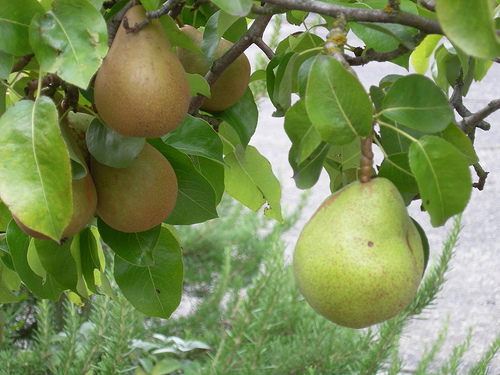
Fruit trees
The most commonly planted fruit trees are apple trees but pear, plum, fig and medlar trees can also produce good results.
Different varieties produce their fruit at different times of year.
The fruit of early ripening trees tends not to keep well whereas later ripening varieties are suitable for storing over winter.
Nurseries attach part of one tree to another recommended for growing fruit – this is called grafting. This joins the healthy rootstock of one tree and the tasty fruit of another. Rootstocks come in various sizes. Look for ones labelled M27 or M9 which suit most gardens, or ask your nursery.
You need to be aware of the potential size your tree will grow to and whether it’s self-fertilising. Self-fertile trees will produce fruit without the need for another tree to pollinate it. If your tree is not self-fertile it will need to be paired with another one.
What to buy
Trees can be bought either in a container or bare-rooted. Look for well-developed fibrous roots. For container grown trees, check that roots aren’t congested and choose younger trees (1-3 years) which tend to establish quicker. Avoid plants that show any sign of disease.
What to do
Preparing the tree
- Soak the roots before planting. Bare-root trees can be planted late autumn to early winter as this is when the tree is in its dormant stage.
- Avoid planting if there’s a frost – place roots into moist soil until conditions improve.
- Container-grown trees can be planted at any time of year except when frosty or if the soil is too dry or too wet.
Planting your tree
- Place your tree in a sunny and sheltered position. This will maximise the time your fruit has to ripen.
- Dig a hole a third wider than the roots and to the same depth as the tree’s roots, firming the bottom of the hole into a slight mound. Insert the stake and your tree.
- Fill in with soil and mound towards the base of the tree attaching it to the stake.
- If you’re growing your tree in a container, half fill a large tub with soil-based potting compost and place your tree on top. Fill the tub with more soil to the base of the tree, water well and feed regularly.
Fruit trees for a small space
A great way to make use of limited space is to train the tree along a south-facing wall or fence. Using a wall or fence allows for a longer ripening time as the wall will soak up the heat.
Make sure the structure is strong enough to support the tree in crop.
Aftercare
- To protect your fruit tree from moths that will destroy the fruit and leaves, apply a grease band 45cm (18in) above soil level to the stake and trunk of your tree.
- This is a sticky paper or glue that will stop wingless female moths being able to reach the branches of the tree to mate, of which its caterpillars will eat the leaves and fruit.
- Grease bands should be applied late October and reapplied as necessary.
- Additionally, apply a plant oil-based winter wash in December or January to kill off any overwintering pests.
Five fruit trees to try
- Malus domestica ‘Queen Cox’ – self-fertile, juicy red-yellow apples from mid October
- Pyrus communis ‘Conference’ – partially self-fertile pear, green-yellow sweet fruit from October to November
- Prunus domestica ‘The Czar’ – self-fertile dark purple dessert plum, resistant to frost
- Ficus carica ‘Brown Turkey’ – self-fertile fig ideal for training along a wall. Rich fruit from August to September
- Mespilus germanica ‘Royal Medlar’ – self-fertile dessert fruit from November

